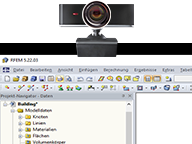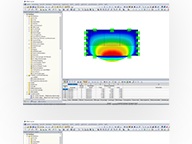Design of Hinged and Restrained Column Bases
The Hinged Column Footing category provides four different base plate connections:
- Simple column base
- Tapered column base
- Column base for rectangular hollow sections
- Column base for circular hollow sections
The Restraint Column Footing category provides five different joint layouts of I-sections:
- Base plate without stiffening
- Base plate with stiffeners in center of flanges
- Base plate with stiffeners on both sides of column
- Base plate with channel sections
- Pocket foundation
All connection types include a base plate welded around a steel column. Connections with anchors are set in concrete within the foundation. You can select anchor types M12 – M42 with steel grades of 4.6 – 10.9. The top and bottom sides of the anchors can be provided with round or angled sheets for better load distribution or anchorage. In addition, you can use rectangular or circular anchor heads with threads applied at the member ends.
The material and thickness of the grout layer, as well as the dimensions and material of the footing, can be set freely. Furthermore, you can define edge reinforcement of the footing. For a better transfer of shear forces, it is possible to arrange a shear key (cleat) on the bottom side of the base plate.
Shear forces are transferred by a cleat, anchors, or friction. You can combine the individual components.
After you have selected the anchorage type and the design standard in the first input window, define the node in Window 1.2 that is to be imported from RFEM/RSTAB and where the footing anchorage is to be designed.
Optionally, you can define the column cross-section and material manually. In the next input windows, you can define the parameters of the base point, such as The loading is imported from RFEM/RSTAB or, in the case of a manual joint definition, the loads are entered.
After the calculation, RF-/JOINTS Steel - Column Base displays the following design results:
- Base plate bending
- Anchor tension and anchor shear force
- Shear key strength
- Concrete compression / failure of concrete edges
- Friction
- Welds
At first, the governing joint designs are arranged in groups and displayed with the basic geometry of the joint in the first result window. In the other result tables, you can see all fundamental design details such as the load-carrying capacity of anchors, stresses in welds, and others.
Dimensions, material specifications, and welds that are important for the construction of the connection are visible immediately and can be printed out. It is possible to visualize the connections in RF-/JOINTS Steel - Column Base or in the RFEM/RSTAB model.
All graphics can be included in the RFEM/RSTAB printout report or printed directly. Due to the scaled output, an optimal visual check is possible as early as in the design phase.

The price is valid for United States.








.png?mw=192&hash=f63e4a3f1836233005de32f60201d5392e507cf1)



